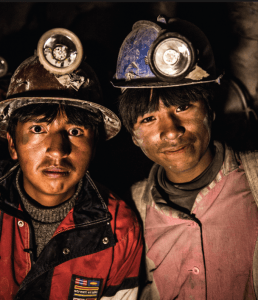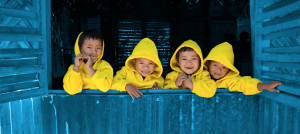Mining and Slave Labor Today
By Evie Gieseman
Slavery in the Mining industry is still present today. Even though there is no specific name for it like slavery or the Mita System, it still continues to exist. This practice is something that has become accepted because of lenient regulation, lack of law enforcement and a family’s need of income.Mining has brought many struggles to Latin America since the arrival and conquest of European powers over indigenous groups. An oppressing affair that has resulted from mining is slave labor and how it has evolved since indigenous Latin American empires. The first form of forced labor in mining was the Mita system developed by the Incan Empire. This organized system was created for the betterment of the Inca community in order to construct roads and infrastructure for the empire[1]. Once Spanish conquistadors arrived, the Mita was shortly turned into a violent labor system. The most common form of forced labor was in the mining sector, which severely decreased the indigenous population. However, the Spanish were not concerned with what happened to the natives or the environment because their main priority was making a profit[2]. Today, there are still forms of slave labor seen in mines all over Latin America, however, one of the most common forms is child labor.

It is estimated that tens of thousands of children are found working in gold mines located in Africa, Asia and South America[3]. In the mines, they work aboveground and underground, enduring harsh physical conditions on their bodies. Underground, many children face the fear of tunnel explosions and breathing in toxic gases daily. Children working above the mine are expected to dig, crush and carry ore for ten hours or more in the blazing sun[4]. There is an unknown number of how many childrens lives are lost to mining each year. Mining leads to the deterioration of a child’s health and causes many injuries. In gold mining, many of the children suffer from mercury poisoning because mercury is used to separate gold from crushed ore[5]. Mercury can seep through the child’s skin or is inhaled. Either way, it is highly toxic and causes illness, disease and death upon the children in the mines. Sickness is also due to the lack of protective wear provided to the children when dealing with mercury.
Many child labor mines are relatively small scale because it makes them more difficult to regulate. Children as young as five years old have been found working in mines making as little as two dollars per day and are forced to work due to poverty[6]. Child labor in mining does not receive the attention it deserves due to these small scale mines. The International Program on the Elimination of Child Labor (IPEC) has traveled to many countries in Latin America with the motive to remove children from the mining sector.
In Bolivia, Ecuador and Peru there are at least 65,000 children working as miners, where they are given and expected to carry out the same jobs as adult miners. Not only do the children miners endure intense physical pain, many of the small scale mining settlements are isolated from large towns. Therefore, they are short on basic needs like housing, medical service, water, electricity and schooling for the children[7]. The younger children are thrown into mining as soon as possible and tend to start off working with their mothers. As the child ages, there becomes a separation in jobs based on gender. The boys start to work in the mines with their fathers, whereas the girls tend to work above the mines, processing ore and separating the minerals from slag[8].

Potosi Bolivia has been known for their vast source of resources and minerals since spanish conquest. The Cerro Rico mine has a long history of slave labor, starting with the Mita system controlled by the Inca Empire, following by the Mita controlled by the Spanish and now child labor. Many children today only have the option to work in the mines because that is what their parents and ancestors have been doing for decades. Roberto Fernandez is the director of Potosi NGO Yachay Mosoj, an organization that strives to keep children in school and out of the mines. Fernandez states many mining parents in Potosi claim they keep their children in school as long as possible, however, they have found many of the claims are not very reliable[9]. Agustin Villanca Menacho is a 14 year old boy working as a miner in Southern Bolivia, specifically at the Cerro Rico mine, where he spends every day extracting silver, zinc and tin. He is a Quechua native that recently lost his father to the mine from lung disease silicosis[10]. Just like Agustin, it is estimated that ten percent of 8,000 miners working in Cerro Rico are younger than 18, which is the legal age to work in the mine. The United Nations International Children’s Fund (UNICEF)is a United Nations organization that provides humanitarian and developmental assistance to children and mothers in developing countries. In 2004, The United Nations International Children’s Fund reported about 4,000 workers in Bolivia’s mining settlements are under the age of 18 years old[11].
The corruption and the unequal distribution of power enables illegal child labor and harsh conditions to continue. There is little local and national Bolivian political involvement against children under the age of 18 in joining the mining workforce. There are labor laws and regulations put in place, however, they aren’t enforced. Lastly, there is no type of social welfare for families that lose their parents to the mines, therefore, their children are forced to work to generate any kind of income. Villanca Menacho tells Global Post that he hopes for a life outside of the mine one day and will return back to school eventually. However, many of the children working in mines have accepted their fate in the mining workforce. For example, Eduardo Colque Conde is fifteen years old and states he thinks he will be forced to work in the mines for the rest of his life[12].
Child labor within the mines will continue to grow unless governments and mining companies take full participation in ending it. Roberto Fernandez, the director of Potosi NGO Yachay Mosoj tells Global Post, “Ending child labor is a fantasy without another form of living”[13]. This means that ending child labor is only possible if other possible economic alternatives are created. It is not something a number of individuals can change, it requires a tremendous unified effort to recognize the problem and take action to make a change.
[1] Mfcresposantac, “Let’s Dive Into the Mita System!”, http://coloniallimapolitics.blogs.wm.edu/2014/10/22/hello-world/
[2]Mfcresposantac, “Let’s Dive Into the Mita System!”, http://coloniallimapolitics.blogs.wm.edu/2014/10/22/hello-world/
[3]International Labour Organization, International Programme on the Elimination of Child Labour (IPEC)4 route des Morillons, CH-1211 Geneva, “Child Labor in Gold Mining: The Problem”,http://www.ilo.org/ipec/areas/Miningandquarrying/MoreaboutCLinmining/lang–en/index.htm
[4]International Labour Organization, International Programme on the Elimination of Child Labour (IPEC)4 route des Morillons, CH-1211 Geneva, “Child Labor in Gold Mining: The Problem”,http://www.ilo.org/ipec/areas/Miningandquarrying/MoreaboutCLinmining/lang–en/index.htm
[5]International Labour Organization, International Programme on the Elimination of Child Labour (IPEC)4 route des Morillons, CH-1211 Geneva, “Child Labor in Gold Mining: The Problem”,http://www.ilo.org/ipec/areas/Miningandquarrying/MoreaboutCLinmining/lang–en/index.htm
[6]Child Labor Coalition Contributor, “Child Mining: 10 Facts”, http://stopchildlabor.org/?p=3853
[7] International Labour Organization, International Programme on the Elimination of Child Labour (IPEC)4 route des Morillons, CH-1211 Geneva, “Child Labor in Gold Mining: The Problem”,http://www.ilo.org/ipec/areas/Miningandquarrying/MoreaboutCLinmining/lang–en/index.htm
[8]International Labour Organization, International Programme on the Elimination of Child Labour (IPEC)4 route des Morillons, CH-1211 Geneva, “Child Labor in Gold Mining: The Problem”,http://www.ilo.org/ipec/areas/Miningandquarrying/MoreaboutCLinmining/lang–en/index.htm
[9]Sara Shahriari, “Global Post: Child Miners in Bolivia”,https://www.cbsnews.com/news/global-post-child-miners-in-bolivia/
[10]Sara Shahriari, “Global Post: Child Miners in Bolivia”,https://www.cbsnews.com/news/global-post-child-miners-in-bolivia/
[11]Sara Shahriari, “Global Post: Child Miners in Bolivia”,https://www.cbsnews.com/news/global-post-child-miners-in-bolivia/
[12]Sara Shahriari, “Global Post: Child Miners in Bolivia”,https://www.cbsnews.com/news/global-post-child-miners-in-bolivia/
[13]Sara Shahriari, “Global Post: Child Miners in Bolivia”,https://www.cbsnews.com/news/global-post-child-miners-in-bolivia